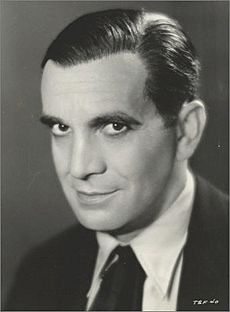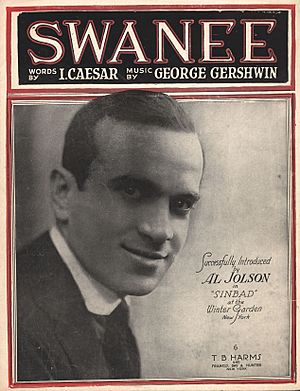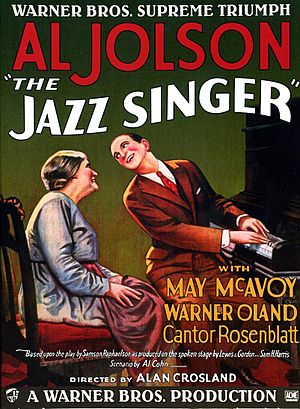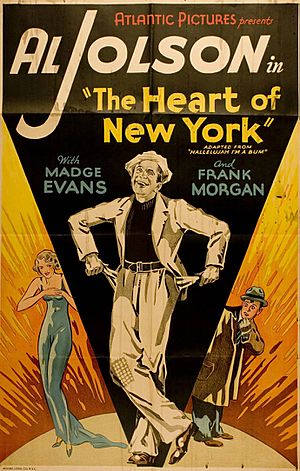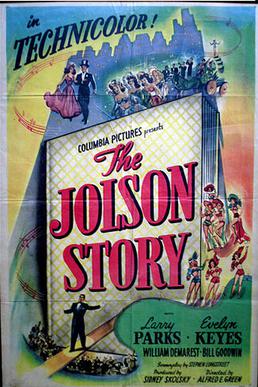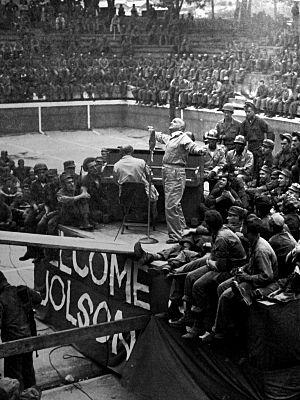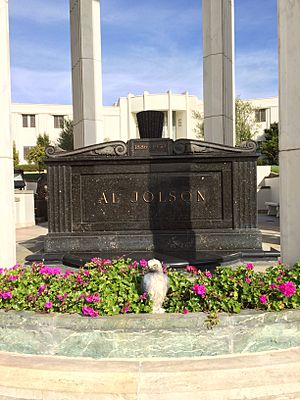Al Jolson facts for kids
Quick facts for kids
Al Jolson
|
|
|---|---|
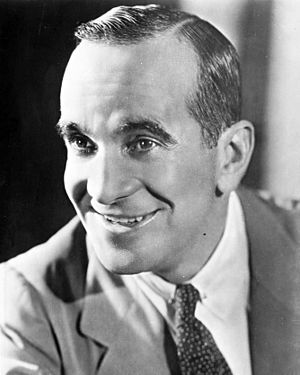
Jolson in 1929
|
|
| Born |
Asa Yoelson
May 26, 1886 Sredniki, Kovno Governorate, Russian Empire
|
| Died | October 23, 1950 (aged 64) San Francisco, California, U.S.
|
| Resting place | Hillside Memorial Park, Culver City, California |
| Other names | Jolie |
| Occupation |
|
| Years active | 1904–1950 |
| Spouse(s) |
Henrietta Keller
(m. 1907; div. 1919)Alma Osbourne
(m. 1922; div. 1928)Erle Galbraith
(m. 1945) |
| Children | 3 (all adopted) |
| Musical career | |
| Genres | |
| Labels |
|
Al Jolson (born Asa Yoelson; May 26, 1886 – October 23, 1950) was a famous Lithuanian-American Jewish singer, comedian, and actor. He was a huge star in the 1920s, known as "The World's Greatest Entertainer." People loved his emotional way of performing. He helped make many songs popular.
Today, he is best known for starring in The Jazz Singer (1927). This was the first movie with talking and singing. He also made many successful musical films in the 1930s.
During World War II, Jolson was the first star to entertain American troops overseas. After a quiet period, he became famous again with the movie The Jolson Story (1946). In this film, Larry Parks played Jolson, and Jolson himself sang the songs. A sequel, Jolson Sings Again, came out in 1949.
In 1950, he was again the first star to entertain soldiers in the Korean War. He performed 42 shows in just 16 days. He died a few weeks after returning to the U.S. This was partly because he was so tired from his performances. Defense Secretary George Marshall later gave him the Medal for Merit for his service.
Music experts say Jolson's style was very important in shaping modern musicals. He made jazz and blues music popular for wider audiences. Even though he sometimes used blackface (which is now seen as wrong), he also helped fight against discrimination for black performers on Broadway.
Contents
- Early Life and Start in Show Business
- Becoming a Stage Performer
- Al Jolson's Movies
- Radio and Television Appearances
- Entertaining Troops During Wartime
- Personal Life
- Death and Legacy
- Awards and Honors
- Influence on Music and Culture
- Performing in Blackface
- Filmography
- Theater
- Songs
- Discography
- See Also
Early Life and Start in Show Business
Al Jolson was born Asa Yoelson in a Jewish village called Srednike. This village is now known as Seredžius in Lithuania. It was part of the Russian Empire at the time. He was the youngest of five children. Jolson was not sure of his exact birth date because records were not kept then.
In 1891, his father, who was a rabbi and cantor (a singer in a synagogue), moved to New York City. He wanted to find a better life for his family. By 1894, his father could bring Jolson, his mother, and his three siblings to the U.S. They arrived in New York and then moved to Washington, D.C. His father became a cantor there.
Jolson's mother, Naomi, died in 1895. After this, he spent some time at a home for orphans in Baltimore. In 1895, he discovered show business. By 1897, Al and his brother Harry were singing on street corners for money. They often used the money to buy tickets to shows.
Becoming a Stage Performer
In 1902, Jolson joined a circus as a singer. The circus eventually closed, and he was out of work. In 1903, he got a small part in a burlesque show. The show closed, but he then teamed up with his brother Harry for vaudeville acts. They performed together across the country.
Around 1904, Jolson started performing in blackface. This was a common practice in entertainment at the time. It helped his career take off. He began wearing blackface in all his shows.
In 1905, his brother Harry left their act. Jolson then performed alone and became very successful as a vaudeville singer. He became a regular performer in San Francisco. In 1909, he joined Dockstader's Minstrels, continuing his blackface performances.
In 1911, Jolson starred in his first musical show, La Belle Paree, in New York City. This show helped launch his career as a big singer. He became very popular singing Stephen Foster songs in blackface. He then starred in other successful musicals like Vera Violetta and The Whirl of Society.
During his shows, Jolson would often tell the audience, "You ain't heard nothing yet!" This became his famous catchphrase. He created a popular blackface character named "Gus." By 1914, his salary had doubled because of his popularity. In 1916, he was the main star in Robinson Crusoe, Jr.. His career grew even more when he starred in Sinbad in 1918. This musical was a huge hit. Songs like "Swanee" and "My Mammy" were added to the show and became very famous. By 1920, Al Jolson was the biggest star on Broadway.
His next play, Bombo, was so popular that it toured nationwide. The theater where he performed was even renamed "Jolson's 59th Street Theatre." At 35, he was the youngest person in American history to have a theater named after him.
Al Jolson's Movies
The Jazz Singer (1927)
Before The Jazz Singer, Jolson appeared in a short talking film called A Plantation Act. This film showed him performing on stage using new sound technology.
Warner Bros. wanted Jolson to star in The Jazz Singer. This movie was special because it was the first full-length film with spoken dialogue and singing. When the movie opened, audiences were amazed. They had never heard actors speak or sing on screen before. Jolson's line, "Wait a minute, wait a minute, you ain't heard nothin' yet!" became iconic.
People were thrilled by Jolson's powerful voice and energetic performances. The movie was a huge success. It showed everyone that talking pictures were the future of movies.
More Early Sound Films
After The Jazz Singer, Jolson made his first "all-talking" movie, The Singing Fool (1928). This film was even more popular than The Jazz Singer. The song "Sonny Boy" from the movie was the first American record to sell one million copies.
Jolson continued to make similar films for Warner Bros. These included Say It with Songs (1929), Mammy (1930), and Big Boy (1930). Some of these films even had scenes in Technicolor. However, audiences started to want different kinds of movies. Jolson then returned to Broadway.
In 1933, he made Hallelujah, I'm a Bum with United Artists. This movie was different because it didn't have "Mammy" songs. Critics liked it and said it was Jolson's best film.
In 1934, he starred in the movie version of his stage play Wonder Bar. This film was set in a Parisian nightclub. It was a big success and helped Jolson's career.
His last film for Warner Bros. was The Singing Kid (1936). In this movie, Jolson made fun of his own stage style. He even sang a song called "I Love to Singa" which joked about "Mammy" songs being old-fashioned. This film also helped the career of black singer Cab Calloway.
In 1939, Jolson starred in Rose of Washington Square with Alice Faye and Tyrone Power. This movie featured many of his famous songs. After this, he made a few guest appearances in other films but did not star in a full movie again for a while.
The Jolson Story (1946)
After a movie about George M. Cohan, Hollywood decided to make a film about Al Jolson's life. The Jolson Story (1946) became a huge hit. Larry Parks played Jolson in the movie, but Jolson himself sang almost all the songs. Larry Parks worked very hard to act like Jolson.
Jolson, who was 60 years old, was too old to play his younger self. But he convinced the studio to let him appear in one scene. He sang "Swanee" in blackface, dancing onto a runway. Because of the movie's success and his tours during World War II, Jolson became a top singer again.
Jolson Sings Again (1949)
A sequel, Jolson Sings Again (1949), was also very popular. It showed scenes from Jolson's war tours. Jolson promoted the movie by visiting theaters in New York. Crowds filled the streets to see him. In Chicago, he sang for 100,000 people at Soldier Field.
Radio and Television Appearances
Jolson was a popular guest on radio shows from the very beginning of radio. In 1928, he sang on NBC's The Dodge Victory Hour to 35 million listeners. He had his own shows in the 1930s, like Presenting Al Jolson. From 1947 to 1949, he hosted the Kraft Music Hall.
Even with younger singers like Bing Crosby and Frank Sinatra, Jolson's career was very successful in the 1940s. In 1948, he was voted "Most Popular Male Vocalist." He was also named "Personality of the Year" in 1949.
Jolson also helped discover two major Hollywood stars: Joan Blondell and James Cagney. He bought the rights to a play and sold them to Warner Brothers. He insisted that Blondell and Cagney, who were in the play, also be in the movie. They both became big stars in gangster movies.
Jolson was unsure about television at first. He thought his big performances might not work well on the small screen. He finally agreed to appear on CBS television in 1950. However, he died suddenly before he could start production.
Entertaining Troops During Wartime
World War II Tours
After the attack on Pearl Harbor in 1941, Jolson felt he needed to help. He offered to entertain American soldiers anywhere in the world. In early 1942, he became the first star to perform at a military base during World War II.
He did as many as four shows a day in places like Central America. He even paid for some of his travel himself. A reporter in England said his first show there caused "pandemonium" and the applause was "like bombs falling."
Jolson was part of the United Service Organizations (USO), which provided entertainment for troops. Because he was over 45, he was given a special rank like an officer. While touring in the Pacific, Jolson got malaria. He had to have one of his lungs removed. In 1946, he received a special award for his volunteer service during the war.
Korean War Tours
In 1950, when the Korean War started, Jolson again offered to help. He called the White House and said he would go to Korea. He was told there were no funds for entertainment. Jolson replied, "Funds? Who needs funds? I got funds! I'll pay myself!"
On September 17, 1950, Jolson arrived in Korea. He traveled at his own expense. He performed 42 shows in just 16 days, working very hard.
Before he left Korea, General Douglas MacArthur gave him a special medal. A few months later, a bridge used to help American troops leave North Korea was named the "Al Jolson Bridge."
Alistair Cooke wrote that Jolson had one last moment of glory in Korea. He sang "Mammy" and the troops cheered. Jack Benny, another famous entertainer, later noted that an amphitheater in Korea was named the "Al Jolson Bowl."
Jolson died ten days after returning from Korea. He had pushed himself too hard, especially with only one lung. Defense Secretary George Marshall later gave Jolson's family the Medal for Merit. The medal recognized that Jolson's service in Korea contributed to his death.
Personal Life
Al Jolson was married four times. His first marriage was to Henrietta Keller in 1907. They divorced in 1919. In 1922, he married Alma Osbourne, but they divorced in 1928.
In 1928, Jolson met Ruby Keeler, a young tap dancer and actress. They fell in love and married on September 21, 1928. In 1935, they adopted a son, Al Jolson Jr. However, Ruby Keeler left Jolson in 1939, and they divorced in 1940.
In 1944, Jolson met Erle Galbraith, an X-ray technologist, at a military hospital. They married on March 22, 1945. During their marriage, they adopted two more children, Asa Jr. and Alicia. They remained married until Jolson's death in 1950.
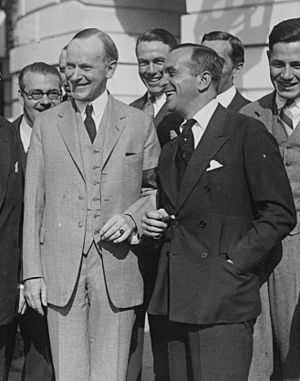
Jolson was a Republican who supported presidents like Warren G. Harding and Calvin Coolidge. He even sang songs for their campaigns. He also supported Franklin D. Roosevelt in 1932, but later went back to supporting Republicans.
Death and Legacy
Al Jolson died of a heart attack on October 23, 1950, in San Francisco. He was 64 years old.
His funeral was one of the biggest in show business history. Police estimated that over 20,000 people attended. Many celebrities paid tribute to him. Bob Hope said the world lost "not only a great entertainer, but also a great citizen." Larry Parks called him "a great American."
Jolson was buried at the Hillside Memorial Park Cemetery in Culver City, California. His mausoleum has a large dome and a bronze statue of him on one knee.
On the day he died, Broadway dimmed its lights to honor him. Radio stations around the world played tributes. Jolson left millions of dollars to charities in his will.
Awards and Honors
Al Jolson has three stars on the Hollywood Walk of Fame. These are for his work in radio, movies, and music.
In 2000, he received a Golden Palm Star in Palm Springs, California. He is also a member of the American Theater Hall of Fame.
The U.S. Postal Service honored him with a 29-cent stamp in 1994. This stamp was part of a series honoring famous American singers. In 2006, a street in New York City was named "Al Jolson Way."
Documentaries about Jolson have also won awards. Al Jolson and The Jazz Singer won first prize at a film festival in Germany in 2008.
Influence on Music and Culture
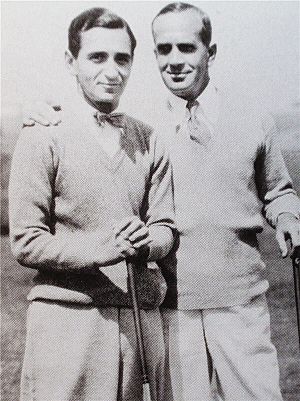
Al Jolson was one of the most popular entertainers in the world. He introduced new music styles like jazz, ragtime, and blues to white audiences. He helped prepare the way for other artists to share black musical traditions. Black songwriter Noble Sissle said Jolson was "always the champion of the Negro songwriter and performer."
However, Jolson's loud and passionate singing style was later replaced by the softer style of "crooners" like Bing Crosby and Frank Sinatra. These singers became popular with the help of microphones.
- Famous songwriter Irving Berlin wrote music for Jolson's films. Jolson performed Berlin's song "Blue Skies" in The Jazz Singer. He also sang hits like "Let Me Sing and I'm Happy" and "Mammy" in Jolson's film Mammy.
- Bing Crosby greatly admired Jolson. He said Jolson had a special "electricity" when he sang. Crosby felt Jolson could "galvanize an audience into a frenzy."
- As a child, singer Bobby Darin loved Jolson's records. He would do Jolson imitations. His manager also started his career by imitating Jolson after seeing The Jolson Story.
- Singer Neil Diamond said the movie The Jazz Singer mirrored his own life. It was about a Jewish kid who leaves his family to pursue music. Diamond starred in a remake of The Jazz Singer in 1980.
- Singer Eddie Fisher often performed Jolson's songs. He sang "Swanee" and "April Showers" in the Kremlin. He also dedicated a song called "Good-bye, G.I. Al" to Jolson.
- Judy Garland paid tribute to Jolson in her concerts. She performed "Swanee" in a style that imitated Jolson.
- Comedian Jerry Lewis starred in a TV version of The Jazz Singer in 1959. He also recorded Jolson's song "Rock-a-Bye Your Baby."
- Singer Jerry Lee Lewis said Jolson was one of only four "true American originals." He loved Jolson's records and listened to them often.
- British singer Rod Stewart said his first musical memory was listening to Al Jolson. He felt it gave him an early love of music.
- African-American singer Jackie Wilson was greatly influenced by Jolson. He recorded a tribute album called You Ain't Heard Nothin' Yet. Wilson believed Jolson was the "stylistic forefather of rock and roll."
- Jolson helped make California famous with his song "California, Here I Come." This song is considered the unofficial song of the state.
Performing in Blackface
Jolson often performed in blackface makeup. This was a common practice for entertainers in the early 1900s. It came from minstrel shows.
However, today, using blackface is seen as a form of racism. It is viewed as wrong because it often made fun of black people.
Some historians say Jolson's blackface and singing style were like a way to show the suffering of Jewish and black people. For example, The Jazz Singer is seen as connecting Jewish religious music with African-American music. One playwright said Jolson's performance felt like a "cantor" (a Jewish religious singer).
Many black people at the time welcomed The Jazz Singer. They saw it as a way for black musicians to get on stage. A Harlem newspaper called it "one of the greatest pictures ever produced."
Relationships with African Americans
Jolson's legacy is complex. While he used blackface, he also had good relationships with African Americans. He learned jazz, blues, and ragtime from black artists. He enjoyed singing these styles.
As a famous Jewish immigrant, Jolson used his influence to help improve racial attitudes. He starred in The Jazz Singer, which introduced black music to wider audiences.
Jolson had many black friends, including famous tap dancer Bill Robinson. As early as 1911, Jolson fought against discrimination on Broadway. He pushed for equal treatment for black performers. For example, he demanded that Cab Calloway be treated equally when they performed together in The Singing Kid.
Jolson once heard that black songwriters Eubie Blake and Noble Sissle were refused service at a restaurant. He found them and took them to dinner, saying he would fight anyone who tried to kick them out. Jolson and Blake became good friends.
Film historian Charles Musser noted that "African Americans' embrace of Jolson was not a spontaneous reaction... Jolson was perceived a friend." Tap dancer Jeni Le Gon remembered that Jolson and Ruby Keeler were the only stars who invited black performers to their home.
British performer Brian Conley said that Jolson was "actually a hero to the black people of America." He noted that black actors honored Jolson at his funeral.
Jolson's energetic style also influenced black performers. Music historian Bob Gulla said Jolson was the "most critical influence" on Jackie Wilson. Wilson felt Jolson should be seen as a "forefather of rock and roll."
The St. James Encyclopedia of Popular Culture states that Jolson helped introduce African-American music to white audiences. He "paved the way for African-American performers like Louis Armstrong and Duke Ellington to bridge the cultural gap between black and white America."
Filmography
| Year | Title | Role | Notes |
|---|---|---|---|
| 1926 | A Plantation Act | Himself | Film debut |
| 1927 | The Jazz Singer | Jakie Rabinowitz | |
| 1928 | The Singing Fool | Al Stone | |
| 1929 | Sonny Boy | Himself | Cameo |
| Say It with Songs | Joe Lane | ||
| New York Nights | Himself | Cameo | |
| 1930 | Mammy | Al Fuller | |
| Showgirl in Hollywood | Himself | Cameo | |
| Big Boy | Gus | ||
| 1933 | Hallelujah, I'm a Bum | Bumper | |
| 1934 | Wonder Bar | Al Wonder | |
| 1935 | Go into Your Dance | Al Howard | |
| 1936 | The Singing Kid | Al Jackson | |
| 1939 | Rose of Washington Square | Ted Cotter | |
| Hollywood Cavalcade | Himself | ||
| Swanee River | Edwin P. Christy | ||
| 1945 | Rhapsody in Blue | Himself | |
| 1946 | The Jolson Story | Uncredited | |
| 1949 | Jolson Sings Again | Uncredited | |
| Oh, You Beautiful Doll | Final film, Uncredited |
Theater
- La Belle Paree (1911)
- Vera Violetta (1911)
- The Whirl of Society (1912)
- The Honeymoon Express (1913)
- Children of the Ghetto (before 1915)
- Robinson Crusoe, Jr. (1916)
- Sinbad (1918)
- Bombo (1921)
- Big Boy (1925)
- Artists and Models of 1925 (1925; added to cast in 1926)
- Big Boy (1926) (revival)
- The Wonder Bar (1931)
- Hold On to Your Hats (1940)
Songs
- "That Haunting Melodie" (1911) – Jolson's first hit.
- "Ragging the Baby to Sleep" (1912) – sold over one million copies.
- "The Spaniard That Blighted My Life" (1912) – another million seller.
- "That Little German Band" (1913)
- "You Made Me Love You (I Didn't Want to Do It)" (1913)
- "Back to the Carolina You Love" (1914)
- "Sister Susie's Sewing Shirts for Soldiers" (1914)
- "Yaaka Hula Hickey Dula" (1916)
- "I Sent My Wife to the Thousand Isles" (1916)
- "I'm All Bound 'Round with the Mason Dixon Line" (1918)
- "My Mammy" (1918)
- "Rock-a-Bye Your Baby with a Dixie Melody" (1918)
- "Tell That to the Marines" (1919)
- "I'll Say She Does" (1919)
- "I've Got My Captain Working for Me Now" (1919)
- "Swanee" (1919)
- "Avalon" (1920)
- "O-H-I-O (O-My! O!)" (1921)
- "April Showers" (1921)
- "Angel Child" (1922)
- "That Wonderful Kid from Madrid" (1922)
- "Toot, Toot, Tootsie" (1922)
- "Juanita" (1923)
- "California, Here I Come" (1924)
- "I Wonder What's Become of Sally?" (1924)
- "I'm Sitting on Top of the World" (1926)
- "When the Red, Red Robin (Comes Bob, Bob, Bobbin' Along)" (1926)
- "Back in Your Own Backyard" (1928)
- "There's a Rainbow 'Round My Shoulder" (1928)
- "Sonny Boy" (1928)
- "Little Pal" (1929)
- "Liza (All the Clouds'll Roll Away)" (1929)
- "Let Me Sing and I'm Happy" (1930)
- "The Cantor (A Chazend'l Ofn Shabbos)" (1932)
- "You Are Too Beautiful" (1933)
- "Anniversary Song" (1946)
- "Alexander's Ragtime Band" (1947)
- "Carolina in the Morning" (1947)
- "About a Quarter to Nine" (1947)
- "Waiting for the Robert E. Lee" (1947)
- "Golden Gate" (1947)
- "When You Were Sweet Sixteen" (1947)
- "If I Only Had a Match" (1947)
- "After You've Gone" (1949)
- "Is It True What They Say About Dixie?" (1949)
- "Are You Lonesome Tonight?" (1950)
- "The Old Piano Roll Blues" (with The Andrews Sisters) (1950)
Discography
- 1946 Al Jolson in Songs He made Famous (Decca)
- 1947 Souvenir Album, Vol. 1 (Decca)
- 1948 Al Jolson, Vol. 3
- 1949 Jolson Sings Again (Decca)
- 1949 Souvenir Album, Vol. 2 (Decca)
- 1949 Souvenir Album, Vol. 4 (Decca)
- 1950 Stephen Foster Songs (Decca)
- 1951 Souvenir Album, Vol. 5 (Decca)
- 1951 Souvenir Album, Vol. 6 (Decca)
See Also
 In Spanish: Al Jolson para niños
In Spanish: Al Jolson para niños


